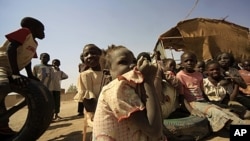The United Nations refugee agency, UNHCR, says up to half a million people could leave Sudan for South Sudan in the coming months. Officials are anticipating a major exodus ahead of an April deadline Khartoum has set for South Sudanese nationals living in the north to register or leave the country.
Sudan has ordered that all South Sudanese nationals in the country register as foreign residents or leave by April 9.
U.N. refugee agency (UNHCR) officials expect hundreds of thousands of people could make the trip in coming months. But it is impossible to know the exact numbers or how much assistance the new arrivals will need.
UNHCR Representative for South Sudan Mireille Girard says the agency is making contingency plans based on a number of possible scenarios.
“In a worst-case scenario, we could have up to 500,000 people hitting the road in a few days’ time, and that will would create a major bottleneck inside South Sudan because the absorption capacity is very stretched already," said Girard.
Girard says the agency expects, that of those returning to South Sudan, up to 100,000 could need emergency assistance.
Many of the returnees, she says, are likely to end up crowded together in the remote town of Renk, just south of the border. Already difficult to reach, the area will become nearly impossible to access by road once the rainy season begins in March.
UNHCR and its partners are already overloaded with an influx of refugees escaping violence in Sudan's Southern Kordofan and Blue Nile states. The fighting, between Sudanese Armed Forces and rebel factions aligned with the south, has displaced some 130,000 people since June, most of whom have fled to South Sudan; the rest to Ethiopia.
Girard says for the new migration to go smoothly, it will require cooperation from all sides. “So if everything goes well, then the movement will be in place, a movement plan as designed by the agencies working in Sudan and those in South Sudan to try to make it happen in an orderly manner with support from the international community, but primarily a movement driven by the two countries. So that is our hope. While we plan for the best, we also have to prepare for the worst,” she said.
Refugees and returnees crossing the border in the coming months will be entering a country struggling with a number of serious humanitarian crises, including inter-tribal fighting in Jonglei that has killed thousands.
Insecurity will also remain a challenge inside refugee camps. There have been a series of bombing raids on camps near the border with Sudan, including one in Unity State in November that the United Nations blamed squarely on Sudanese forces.
There was a similar bomb attack on another camp in Upper Nile state last month.
In whatever numbers, the new arrivals to South Sudan are likely to add to the burden of a fragile new nation that already has its hands full.
Returnees Could Present South Sudan's Next Big Crisis
- By Gabe Joselow










